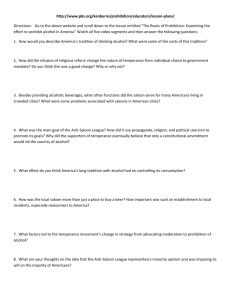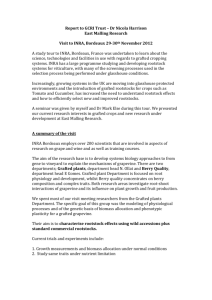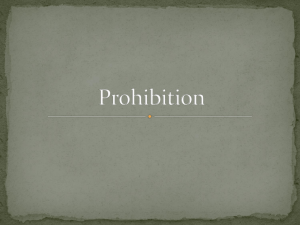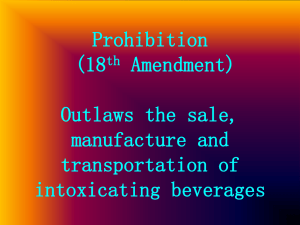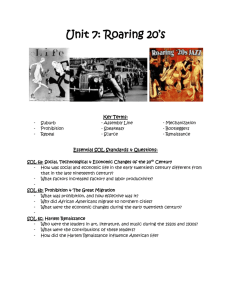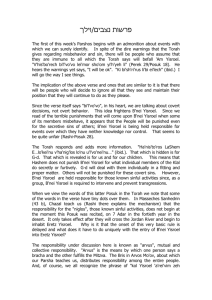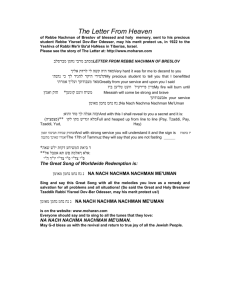Harkavas ilan
advertisement
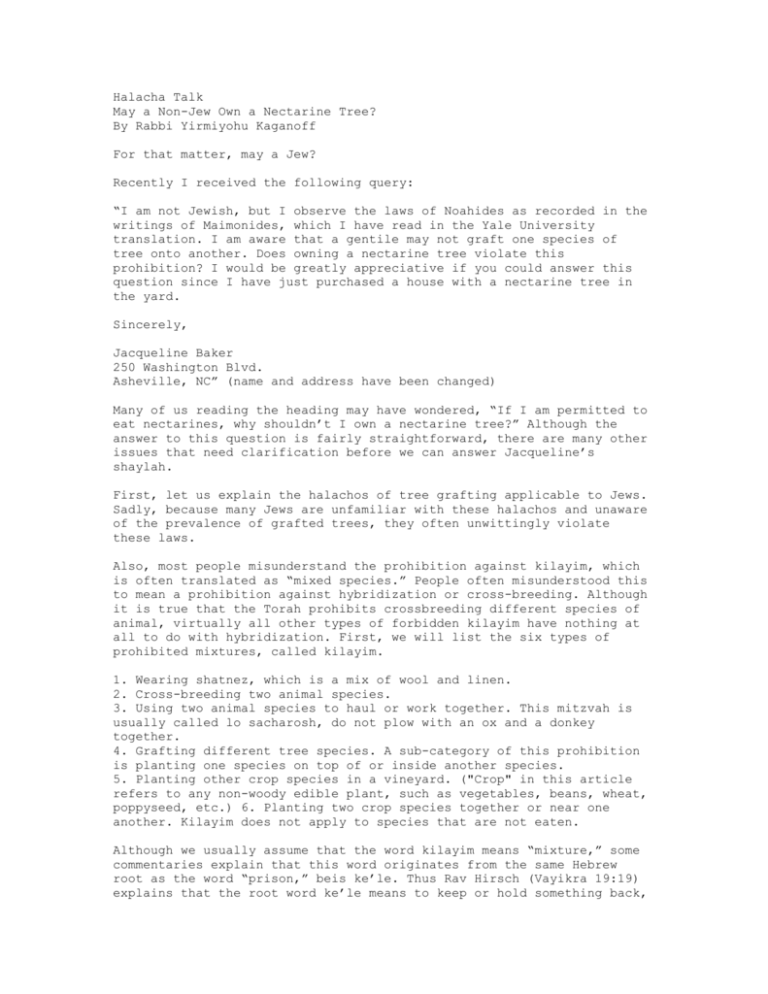
Halacha Talk May a Non-Jew Own a Nectarine Tree? By Rabbi Yirmiyohu Kaganoff For that matter, may a Jew? Recently I received the following query: “I am not Jewish, but I observe the laws of Noahides as recorded in the writings of Maimonides, which I have read in the Yale University translation. I am aware that a gentile may not graft one species of tree onto another. Does owning a nectarine tree violate this prohibition? I would be greatly appreciative if you could answer this question since I have just purchased a house with a nectarine tree in the yard. Sincerely, Jacqueline Baker 250 Washington Blvd. Asheville, NC” (name and address have been changed) Many of us reading the heading may have wondered, “If I am permitted to eat nectarines, why shouldn’t I own a nectarine tree?” Although the answer to this question is fairly straightforward, there are many other issues that need clarification before we can answer Jacqueline’s shaylah. First, let us explain the halachos of tree grafting applicable to Jews. Sadly, because many Jews are unfamiliar with these halachos and unaware of the prevalence of grafted trees, they often unwittingly violate these laws. Also, most people misunderstand the prohibition against kilayim, which is often translated as “mixed species.” People often misunderstood this to mean a prohibition against hybridization or cross-breeding. Although it is true that the Torah prohibits crossbreeding different species of animal, virtually all other types of forbidden kilayim have nothing at all to do with hybridization. First, we will list the six types of prohibited mixtures, called kilayim. 1. Wearing shatnez, which is a mix of wool and linen. 2. Cross-breeding two animal species. 3. Using two animal species to haul or work together. This mitzvah is usually called lo sacharosh, do not plow with an ox and a donkey together. 4. Grafting different tree species. A sub-category of this prohibition is planting one species on top of or inside another species. 5. Planting other crop species in a vineyard. ("Crop" in this article refers to any non-woody edible plant, such as vegetables, beans, wheat, poppyseed, etc.) 6. Planting two crop species together or near one another. Kilayim does not apply to species that are not eaten. Although we usually assume that the word kilayim means “mixture,” some commentaries explain that this word originates from the same Hebrew root as the word “prison,” beis ke’le. Thus Rav Hirsch (Vayikra 19:19) explains that the root word ke’le means to keep or hold something back, and that the plural form kilayim is similar to yadayim or raglayim and means a pair. Therefore the word kilayim means to pair together two items that should be kept apart. In order to explain the prohibition against grafting trees, the subject of our article, I will first provide some scientific background for city dwellers like myself, who know almost nothing about gardening and horticulture. Having been a city slicker almost my whole life, I freely admit that I knew little about this subject until I did some research in order to understand the halacha. Hybridization (cross-breeding) of plants occurs when one pollinates the flower of one species with pollen from a different species. However, most of the prohibitions of kilayim have nothing to do with crossbreeding species. In the case of “herbaceous plants,” that is plants other than trees and shrubs, kilayim is a prohibition against planting two crop species close together. The halacha prohibits planting an alien crop species inside a vineyard, planting one species very close to another already planted species, planting one species on top or inside another species, and planting the seeds of two species together. Incidentally, these prohibitions apply only in Eretz Yisroel, with the exception of planting a different species inside a vineyard (Gemara Kiddushin 39a) and possibly of planting one species inside another (see Gemara and Tosafos Chullin 60a; Rambam, Hil. Kilayim 1:5 and Radbaz). Thus, someone in Chutz La’Aretz may plant his backyard garden with a wide variety of vegetables and other edibles without any halachic concern, whereas in Eretz Yisroel, someone planting a garden patch must be very careful to keep the different species separate. The complicated question of how far apart to plant them, and what qualifies as a valid separation if one plants them close together, is beyond the scope of this article (see Chazon Ish, Hil. Kilayim 6:1). (By the way, the halachic definition of a species often differs from scientific definitions. For example, although some scientists consider wolves and dogs to be the same species, halacha does not; therefore one may not crossbreed them or use them to haul a load together [Mishnah Kilayim 1:6]. On the other hand, the Chazon Ish [3:7] discusses whether all citrus fruits are the same species concerning the laws of kilayim, which would permit grafting a grapefruit tree onto a lemon stock, whereas scientists consider them as two distinct species. According to the majority opinion, an esrog grafted onto a lemon tree is non kosher for the mitzvah on Sukkos, although the grafter may not have violated any Torah prohibition in the process.) HARKAVAS ILAN – CROSS-GRAFTING The laws of kilayim also prohibit grafting a branch of one species of tree onto the wood stock, or lower trunk, of another species. Although a town dweller may feel that this is a rare occurrence, in fact, contemporary plant nurseries and tree farmers usually graft branches of a species that produces delicious fruit onto the hardier stock of a different species. For example, most modern peach and nectarine trees are produced by grafting a peach or nectarine branch onto the stock of a hardier tree, such as an almond. As I will explain, someone who performs this, either in Eretz Yisroel or in Chutz La’Aretz, violates a Torah prohibition whether he is Jewish or not. Therefore, a Jew who hires or requests a non-Jew to graft such a tree, or even to prune or water it after it was implanted, contravenes lifnei iveir, causing someone else to break a prohibition. Because so many trees are grafted nowadays, someone who owns a peach tree should have a horticultural expert check whether its stock is also a peach tree, or whether it is of a different species. If the stock is peach, even of a different variety, he may keep the tree; if the stock is of a different species, he should chop off the tree below the point of the graft. (Some have suggested that George Washington chopped down his father’s cherry tree because it was grafted onto a different species. If this is true, George did an additional good deed, at least according to some opinions, besides telling the truth afterwards.) As we will see shortly, there is no violation of baal tashchis in cutting down this tree. Often even a non-expert can detect if a tree was grafted onto a different species by simply scrutinizing the tree. If the bark somewhere near the bottom of the tree looks very different from the upper part of the tree, this indicates that the upper part of the tree was grafted, possibly onto a different species. Before purchasing a new tree at a nursery, examine the trunk carefully for signs of grafting. If indeed this tree is the product of a graft onto a different species, then watering or pruning it violates a Torah law, as I will explain. Furthermore, one may not use the sprinkler to irrigate the rest of the lawn if this tree will benefit. NECTARINE TREES Nectarine trees are susceptible to a host of plant diseases, and as a result are usually grafted onto the stock of peach, plum, almond or other trees. It is unclear whether peach and nectarine are halachically considered the same species or not, but the other species are certainly different species halachically. Therefore, although cross-pollinating different species does not violate halacha, watering a nectarine tree grafted onto a different species stock does. By the way, one may plant or maintain different species of trees in close proximity, presumably because grown trees do not look mixed together but stand distinct. DOES THE PROHIBITION AGAINST GRAFTING APPLY IN CHUTZ LA’ARETZ? Although most agricultural mitzvos (mitzvos hateluyos ba’aretz), such as terumah, maaser, and shmittah, apply only in Eretz Yisroel, some of these mitzvos also apply in Chutz La’Aretz, such as the mitzvah of orlah, which prohibits using fruit that grows on a tree before it is three years old. Although the laws of orlah differ when the tree grows in Chutz La’Aretz, the fruit produced before the tree is three years old is nevertheless prohibited. Where does kilayim fit into this picture? Of course, some prohibitions, such as shatnez, cross-breeding animals and are not agricultural and therefore apply equally in Eretz in Chutz La’Aretz. Among the agricultural prohibitions of kilayim lo sacharosh Yisroel and kilayim, some apply in Chutz La’Aretz also, whereas others apply only in Eretz Yisroel. . Planting vegetables and other edible crops together applies only in Eretz Yisroel, grafting trees applies equally in Chutz La’Aretz and in Eretz Yisroel min hatorah, while planting in a vineyard applies in Chutz La’Aretz but only midirabbanan (Gemara Kiddushin 39a). MAY ONE OWN KILAYIM? The Gemara (Moed Katan 2b) cites a dispute whether maintaining kilayim in a vineyard (in Eretz Yisroel) is prohibited min hatorah. Rabbi Akiva contends that building a fence to protect kilayim violates a Torah law, whereas the Sages contend that it does not (Rashi to Avodah Zarah 64a). Most poskim conclude that one may not own kilayim but must rip it up (Shulchan Aruch Yoreh Deah 297:2); Rambam (Hil. Kilayim 1:2) paskins like the Sages that this is prohibited only midirabbanan whereas Rosh (Hil. Kelayim #3) prohibits this min hatorah. (Note that Shu’t Chasam Sofer [Yoreh Deah #282] contends that Tosafos [to Avodah Zarah 64a s.v. Rabbi Akiva] permits owning kilayim.) WHAT ABOUT OWNING A GRAFTED TREE? Most poskim assume that one may not own a kilayim tree just as one may not own kilayim in a vineyard. Furthermore, they contend that this halacha applies whether the tree is in Eretz Yisroel or in Chutz La’Aretz (Rosh, Hil. Kilayim Chapters 1& 3; Pischei Teshuvah, Yoreh Deah 295:2, quoting many poskim). However, many observant Jews purchased agricultural properties that contained kilayim trees and they did not cut down those trees. Was there any justification for their actions? Many halachic responsa discuss what was apparently a widespread practice in the eighteenth and nineteenth century. Whereas most poskim rule that these Jews violated the halacha, some authorities justify the practice of owning these trees at least in Chutz La’Aretz (Shu’t Chasam Sofer, Yoreh Deah #288; cf. Aruch HaShulchan, Yoreh Deah 295:17-18). Even these opinions agree that it is preferred to follow the stricter approach and cut down the grafted part of the tree. I THOUGHT THAT ONE MAY NOT CUT DOWN A FRUIT-BEARING TREE? Although it is usually prohibited to chop down a tree that bears enough fruit to be profitable, this prohibition does not exist when owning the tree involves a prohibition. Furthermore, baal tashchis generally does not exist when one is trying to enhance one’s observance of mitzvos. Nevertheless, it is preferred to have a non-Jew chop down the tree since he has no mitzvah of baal tashchis. WHY DOES THIS MITZVAH APPLY TO NON-JEWS? The Gemara (Sanhedrin 56b) quotes a dispute about this question. According to the Sages, the prohibition of kilayim does not apply to Bnei Noach, whereas according to Rabbi Elazar, Bnei Noach are included in some of the kilayim prohibitions but not others. Specifically, they are prohibited from mating different animal species and from grafting one species of fruit tree onto another, but they may plant different species together or in a vineyard, or wear shatnez. Why are they included in one prohibition but not the other? Describing the creation of plants, the Torah says: “And G-d said, ‘The earth shall sprout forth vegetation, herbage that produces seed; Edible trees that produce fruit of their own species’ … And the earth produced vegetation, herbage that produces seed of its own species and trees that bear seed-bearing fruit of their own species.” (Breishis 1:11-12). Reading the pasuk carefully, we see that Hashem ordered only the trees, and not the herbaceous plants, to “produce fruit of their own species.” Even though the herbage did in the end produce “seed of its own species,” this was not because it was commanded. The Gemara derives from other sources that just as the earth was commanded to keep tree species distinct, so too, Adam HaRishon and all his descendants were commanded to keep these species distinct. But since the herbaceous world was never commanded to keep its species distinct, Adam was not commanded concerning this halacha. Therefore, although Jews may not plant them together, Bnei Noach may (Yerushalmi Kilayim 1:7, quoted by Gra to Yoreh Deah 295:2). WHICH OPINION DO WE FOLLOW? Do we rule like the Sages that a non-Jew is not included in the prohibition of harkavas ilan, or like Rabbi Elazar that he is? The Rambam (Hilchos Melachim 10:6) rules like Rabbi Elazar that a non-Jew may not graft one species of tree onto another, whereas the Ritva (Kiddushin 39a s.v. Amar Rabbi Yochanan) and the Shach (Yoreh Deah 297:3) are lenient. Although we usually follow the Rambam’s opinion, some poskim suggest that we might be able to rule leniently if only a rabbinic prohibition is involved, such as where the grafted tree exists already and one is not watering or pruning it (Chazon Ish, Kilayim 1:1). MS. BAKER’S SHAYLAH I mentioned earlier that a Jew who prunes or waters a kilayim tree violates the Torah prohibition whether in Eretz Yisroel or in Chutz La’Aretz. According to most authorities, one may not even own this tree and one is required to cut down the grafted part. However since this last prohibition is only midirabbanan according to most poskim, nonJews may allow a grafted tree to survive and may even build a fence around it since they are not required to observe Rabbinic prohibitions. (Compare, however, Shu’t Mahari Asad, Yoreh Deah #350 and Shu’t Maharsham 1:179.) However, if the tree is grafted onto other species, Ms. Baker may not water or prune it because that is halachically equivalent to planting it which is prohibited according to most opinions. In my opinion, she may also not operate her sprinkler system to irrigate her lawn if the kilayim tree will benefit as a result. May Ms. Baker ask another non-Jew to water her tree? The poskim dispute whether a non-Jew may ask or hire someone else to violate a mitzvah. Most contend that this is permissible, because the mitzvah of lifnei iveir, causing someone else to violate a mitzvah, does not apply to non-Jews (Tosafos, Avodah Zarah 16b s.v. linachri). Other poskim (Ginas Veradim, Klal 43) prohibit this, basing themselves on earlier sources that prohibit a ben Noach from violating a transgression that logic tells us to avoid (Rabbeinu Nissim, Introduction to Shas). MAY WE EAT THE FRUITS OF A GRAFTED TREE? One may eat the fruits of a grafted tree (Rambam, Hil. Kilayim 1:7, based on Yerushalmi). One may even take the shoot of a grafted tree and plant it after it has been severed from the original tree. In all the six types of kilayim mentioned above, the general criterion is to avoid the appearance of different species being intermingled. Concerning this, Rav Hirsch (Vayikra 19:19) writes, “The Great Lawgiver of the world separates the countless numbers of His creations in all their manifold diversity, and assigns to each one of them a separate purpose and a separate form for its purpose.” In addition, observing the laws of kilayim helps us remember how various species obeyed Hashem’s instructions to remain separate during their creation, (the source for some halachos of kilayim as we saw above). This reminds the contemplative Jew that if the plants heeded Hashem’s word during the Creation, how much more are we obligated to obey all His instructions. The author thanks Rabbi Shmuel Silinsky for his tremendous assistance in providing the horticultural information in this article.


